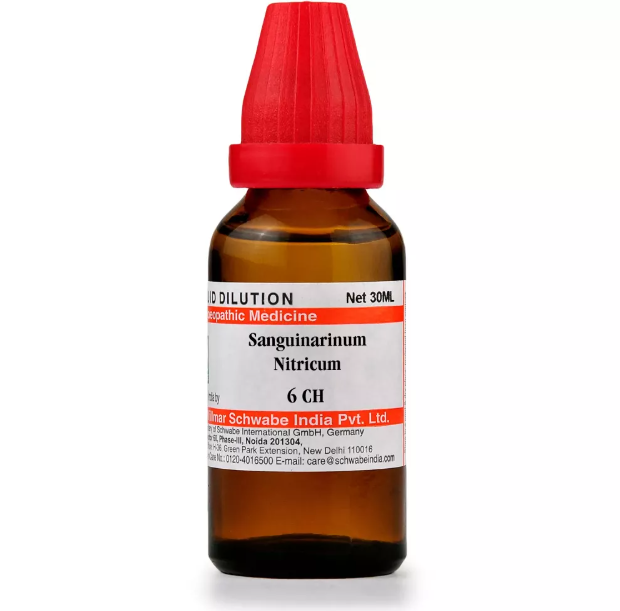SANGUINARINUM NITRICUM 6C, 12C, 30C, 200C, 1M, 10M USES AND SYMPTOMS
 SANGUINARINUM NITRICUM
SANGUINARINUM NITRICUM
(Nitrate of Sanguinarine)
Sangin-n.
Effective for nasal polyps, acute and chronic catarrh, and acute pharyngitis. Useful for smarting and burning in the throat and chest, particularly under the sternum. Treats influenza, lachrymation, eye and head pain, sore scalp, and a sense of obstruction. Addresses chronic follicular pharyngitis.
Nose: Feels obstructed with profuse, watery mucus and burning pain. Enlarged turbinates (adenoids) mark the start of hypertrophy. Scant secretion with a tendency to dryness, small bleeding crusts, and post-nasal secretions difficult to dislodge. Dry, burning nostrils with watery mucus and pressure at the nose’s root. Nostrils blocked with thick, yellow, bloody mucus. Sneezing and rawness in posterior nares.
Mouth: Ulceration on the tongue’s side.
Throat: Rough, dry, constricted, burning. Sore right tonsil, dysphagia.
Respiratory: Short, hacking cough with thick, yellow, sweetish mucus. Pressure behind the sternum, dryness, and burning in the throat and bronchi. Tickling cough and chronic nasal, laryngeal, and bronchial catarrh. Altered, deep, hoarse voice.
Relationship: Compare with Sanguinarinum tartaricum (exophthalmos, mydriasis, dim vision), Arum-t., Psor., Kali-bi.
SYMPTOMS OF SANGUINARINUM NITRICUM
Nose:
Feels blocked
Profuse, watery mucus with burning pain
Enlarged turbinates (adenoids) at the start of hypertrophy
Scant secretion, tendency to dryness
Small bleeding crusts when removed
Post-nasal secretions adhere to nasopharynx and are hard to dislodge
Dry, burning nostrils with watery mucus, pressure at nose root
Nostrils filled with thick, yellow, bloody mucus
Sneezing and rawness in posterior nares
Mouth:
Ulceration on the side of the tongue
Throat:
Rough, dry, constricted, burning
Right tonsil sore, difficulty swallowing
Respiratory:
Short, hacking cough with thick, yellow, sweetish mucus
Pressure behind the sternum
Dryness and burning in throat and bronchi
Tickling cough
Chronic nasal, laryngeal, and bronchial catarrh
Altered voice, deep, hoarse
selection of the potency
Individualization:
- Homeopathy is based on the principle of treating the individual, not just the disease. The unique symptoms and characteristics of the person are crucial in determining the most suitable potency.
Intensity of Symptoms:
- The intensity of the symptoms guides the choice of potency. If the symptoms are intense and acute, a lower potency (e.g., 6C, 30C) might be considered. For chronic conditions with less intensity, higher potencies (e.g., 200C, 1M) may be appropriate.
Sensitivity of the Patient:
- Some individuals are more sensitive to homeopathic remedies, while others may require higher potencies. The practitioner considers the patient’s sensitivity when selecting the potency.
Acute vs. Chronic Conditions:
- Lower potencies are often used for acute conditions, while higher potencies may be considered for chronic or long-standing issues.
Previous Response to Potencies:
- The patient’s response to previous homeopathic treatments helps guide the choice of potency. If a particular potency has been effective in the past, it may be repeated or adjusted as needed.
Vital Force and Susceptibility:
- Homeopathy views illness as a disturbance in the vital force. The practitioner assesses the patient’s overall vitality and susceptibility to determine the appropriate potency.
Aggravation or Amelioration:
- The direction of the symptom response (aggravation or amelioration) after taking a remedy can influence the choice of potency.
Miasmatic Considerations:
- In classical homeopathy, the concept of miasms (inherited disease tendencies) is considered. The practitioner take this into account when selecting the potency.
Practitioner Experience:
- The experience and preference of the homeopathic practitioner play a role. Some practitioners may have success with certain potencies based on their clinical experience.
SAFETY INFORMATION
- Do not exceed the recommended dose by physician
- Keep out of the reach of children
- Store in a cool dry place away from direct sunlight
- Maintain half an hour gap between food/drink/any other medicines and homoeopathic medicine
- Avoid any strong smell in the mouth while taking medicine e.g. camphor, garlic, onion, coffee, hing
Medicine images use for reference only selection of homeopathic medicine depends on the individual’s specific symptoms and overall constitution. Moreover, homeopathy is a holistic system of medicine that treats the individual as a whole. In addition to addressing the physical symptoms, it takes into account the emotional and mental state of the person. Consequently, it’s crucial to consult with a qualified homeopathic practitioner for personalized treatment.
The information provided on this website is intended solely for educational purposes. Always seek the advice of your physician or other qualified health provider.
